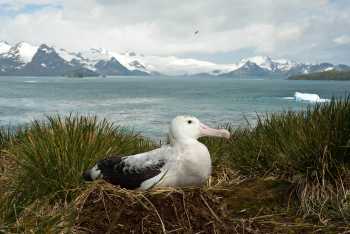Andy Clarke (British Antarctic Survey) and colleagues, writing in the journal British Birds, have described South Georgia (Islas Georgias del Sur)* as an Important Bird Area (IBA).
"The function of the BirdLife Important Bird Area (IBA) Programme is to identify, protect and manage a network of sites that are significant for the long-term viability of naturally occurring bird populations, across the geographical range of those bird species for which a site-based approach is appropriate."
The paper's abstract follows:
"The mountainous island of South Georgia, situated in the cold but productive waters of the Southern Ocean, is one of the world's most important seabird islands. It is estimated that over 100 million individual seabirds are based there, and that there may have been an order of magnitude more before the introduction of rats. South Georgia has 29 species of breeding bird, and is the world's most important breeding site for six species (Macaroni Penguin Eudyptes chrysolophus, Grey-headed Albatross Thalassarche chrysostoma, Northern Giant Petrel Macronectes halli, Antarctic Prion Pachyptila desolata, White-chinned Petrel Procellaria aequinoctialis and Common Diving Petrel Pelecanoides urinatrix). It is also probably in the top three such sites for seven others (King Penguin Aptenodytes patagonicus, Gentoo Penguin Pygoscelis papua, Wandering Albatross Diomedea exulans, Black-browed Albatross Thalassarche melanophris, Southern Giant Petrel Macronectes giganteus, Black-bellied Storm-petrel Fregetta tropica and South Georgia Diving Petrel Pelecanoides georgicus). Several of these species are globally threatened or near-threatened, which enhances the importance of South Georgia and emphasises the need for action to improve the conservation status of its birds. Although South Georgia is currently classified by BirdLife International as a single Important Bird Area (IBA), closer scrutiny may well reveal that it would better be considered as comprising several distinct IBAs. Current threats to the South Georgia avifauna include rats, regional climate change, and incidental mortality in longline and trawl fisheries outside the Southern Ocean. The 2010/11 austral summer marked the start of a major campaign to eliminate rats. Local fisheries are now well regulated but South Georgia albatrosses and petrels are still killed in large numbers in more distant fisheries. Furthermore, there is probably little that can be done to mitigate the effects of climate change."
See also the BirdLife International IBA account for South Georgia (Islas Georgias del Sur)*.
An earlier paper in British Birds describes another important South Atlantic island group, Tristan da Cunha and Gough Island, which has been designated as an IBA. See also http://www.birdlife.org/datazone/ebafactsheet.php?id=86.

A Wndering Albatross breeds on Prion Island, with South Georgia (Islas Georgias del Sur)*
in the background
Photograph by Anton Wolfaardt
References:
Clarke, A., Croxall, J.P., Poncet, S., Martin, A.R. & Burton, R. 2012. Important Bird Areas: South Georgia. British Birds 105: 118-144.
Ryan, P.G. 2008. Important Bird Areas: Tristan da Cunha and Gough Island. British Birds 101: 586-606.
John Cooper, ACAP Information Officer, 25 August 2012
*A dispute exists between the Governments of Argentina and the United Kingdom of Great Britain and Northern Ireland concerning sovereignty over the Falkland Islands (Islas Malvinas), South Georgia and the South Sandwich Islands (Islas Georgias del Sur y Islas Sandwich del Sur) and the surrounding maritime areas.

 Français
Français  English
English  Español
Español